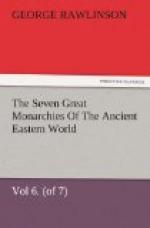The river of Nishapur is formed by numerous small streams, which descend from the mountains that on three sides inclose that city. Its water is at times wholly consumed in the cultivation of the plain; but the natural course may be traced, running in a southerly and south-westerly direction, until it debouches from the hills in the vicinity of Tersheez. The Miyanabad stream is believed to be a tributary of the Gurghan. It rises from several sources in the transverse range joining the Alatagh to the Jaghetai, the streams from which all flow westward in narrow valleys, uniting about long. 57 deg. 35’. The course of the river from this point to Piperne has not been traced, but it is believed to run in a general westerly direction along the southern base of the Alatagh, and to form a junction with the Gurghan a little below the ruins of the same name. Its length to this point is probably about 200 miles.
The elevation of the mountain chains is not great. No very remarkable peaks occur in them; and it may be doubted whether they anywhere attain a height of above 6000 feet. They are for the most part barren and rugged, very scantily supplied with timber, and only in places capable of furnishing a tolerable pasturage to flocks and herds. The valleys, on the other hand, are rich and fertile in the extreme; that of Meshed, which extends a distance of above a hundred miles from north-west to south-east, and is from twenty to thirty miles broad, has almost everywhere a good and deep soil, is abundantly supplied with water, and yields a plentiful return even to the simplest and most primitive cultivation. The plain about Nishapur, which is in length from eighty to ninety miles, and in width from forty to sixty, boasts a still greater fertility.
The flat country along the southern base of the mountains, which ancient writers regard as Parthia, par excellence, is A strip of territory about 300 miles long, varying in width ac cording to the labor and the skill applied by its inhabitants to the perfecting of a system of irrigation. At present the kanats, or underground water-courses, are seldom carried to a distance of more than a mile or two from the foot of the hills; but it is thought that anciently the cultivation was extended considerably further. Ruined cities dispersed throughout the tract sufficiently indicate its capabilities, and in a few places where much attention is paid to agriculture the results are such as to imply that the soil is more than ordinarily productive. The salt desert lies, however, in most places within ten or fifteen miles of the hills; and beyond this distance it is obviously impossible that the “Atak” or “Skirt” should at any time have been inhabited.




